Candy Chemistry: Homemade Peanut Brittle
Candy, especially good home-made candy, is a great way to inject a bit of fun into your every-day life! Sadly, candy making can be seen as technically difficult, or as something only made by generations past. But peanut brittle—with its crisp texture and combination of sweet and salty flavors and rich mouth-feel—is actually one of the easiest candies to make! But don’t let this candy’s simplicity fool you, there’s some serious chemistry going on right under your nose.
For instance, the sugar used in brittle (or nearly any candy making, for that matter) undergoes a process called Sugar Inversion. Applying heat to sugar (table sugar, called sucrose by scientists) causes inversion, the splitting of sucrose into fructose and glucose in liquid form. Then, as the temperature increases, acids accumulate, the color of the sugar darkens, and flavors and aromas become more complex. It’s all very complex chemistry, but luckily for us, it happens whether we know what a reducing reaction is or not! All we need to do is keep track of the temperatures and add things at the right time. Let’s take a closer look.
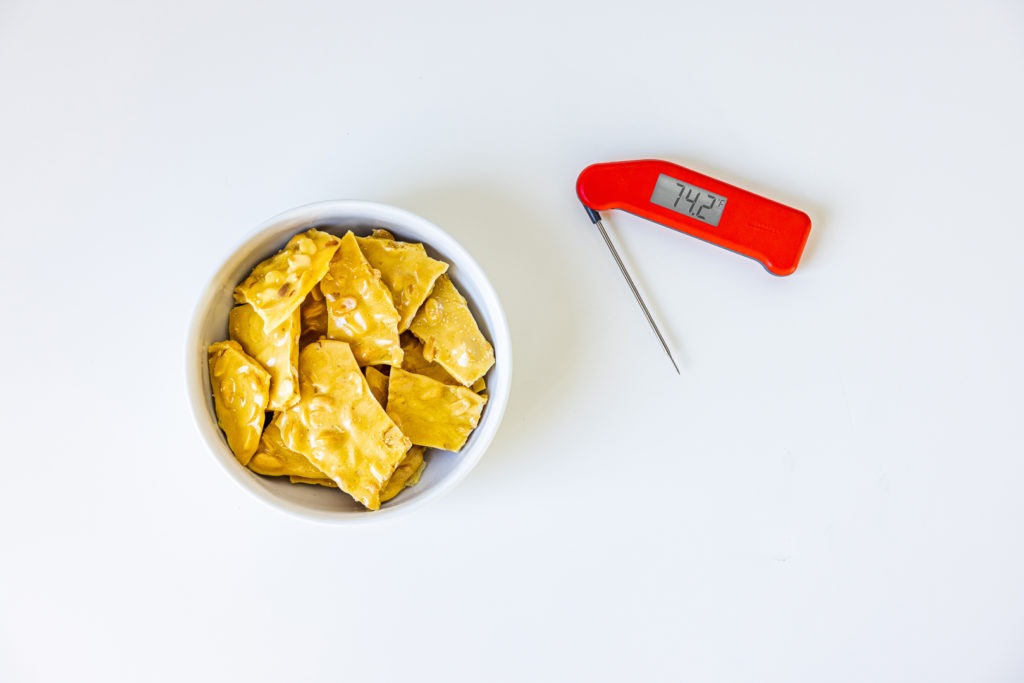
Sugar Cooking Stages
There are many different stages your syrup will go through as the temperature of a sugar solution rises, and for your recipe to be successful, the final temperature must be measured accurately. Some use the cold water test with sugar cooking by taking a small amount of cooked sugar, dropping it into cold water to test its consistency when set. But this is a pre-technological answer to a very complex problem, and is, at best, haphazard for the novice.
The problem is, while you’re testing the little drop of sugar, the temperature of the sugar in the pan is still rising. Even if you remove it from the heat, carryover cooking (and the exothermic reactions in caramelizing sugars) will continue to increase the temperature while you test. In fact, as the amount of water in the solution decreases, the temperature will begin increasing at a faster pace.
The very best way to check the candy stage is with a high-speed thermometer. Measuring the temperature gives you a direct reading of the sugar concentration, which is just what you want.
The Best Candy Thermometer
You need to instantly and accurately read the sugar’s temperature. A Thermapen®is always our instant-read thermometer of choice when making candy because of its thermal range, accuracy, and speed. Whatever you do, don’t cook sugar without an accurate instant-read thermometer.
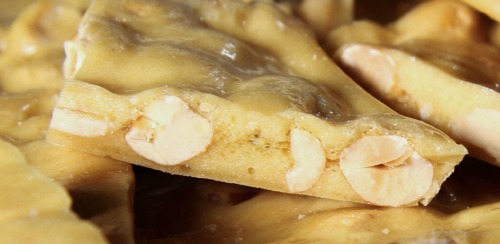
In The Baking Bible (pg. 513), Rose Levy Beranbaum gives some great advice pertaining to reaching your target temperature when cooking sugar:
When heating sugar syrups and caramel, as the mixture approaches the desired finished temperature, be sure that the burner heat is no higher than medium-low. This helps to prevent the temperature of the syrup from rising after the syrup is removed from the heat.
What Makes it Brittle?
The sugar will be cooked to 300ºF (149ºC)—hard crack stage; which when set up would be hard like a lollipop. But peanut brittle is delicate and you can easily bite into it—how? The secret is in the baking soda.
As the sugar is cooking and begins turning amber in color it accumulates small amounts of acid, and that acid reacts chemically with the alkaline baking soda releasing about a zillion minuscule bubbles of CO2 that get trapped, making the sugar porous and, well…brittle.
Adding the baking soda at the end is important because you need to wait for enough acid to accumulate, and the candy needs to be poured out onto the prepared pan to set up as soon as the chemical reaction occurs. Aeration of the sugar will cause the clear, glassy syrup to turn opaque immediately, and it will increase in volume—so be sure to use a saucepan large enough for the job.
In our post, Caramel Apple Perfection, we introduced the topic of cooking sugar. The same principle of reducing the incidence of crystallization is important with this project. Corn syrup helps to catalyze the sugar inversion in this recipe.
Print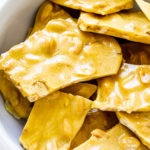
Homemade Peanut Brittle
Description
Delicious homemade peanut brittle
Ingredients
- 1 C granulated sugar
- 1/2 C light corn syrup
- 1/2 C water
- 1 C peanuts (salted is best)
- 1 Tbsp butter
- 1 tsp baking soda
- 1/2 tsp vanilla extract
Instructions
Step 1. Place a silicone baking mat onto a half-size sheet pan, or grease the pan well. Keep a Thermapen on the kitchen counter right by your stovetop where you’ll be working.
Step 2. In a medium saucepan combine water, sugar, and corn syrup. Clean the sides of the pan with a pastry brush and water. Turn the heat on to medium-high and allow to heat to 270°F (132°C), checking with your Thermapen to hit the temp on the nose. Do not stir.
Step 3. Once the sugar has reached 270ºF (132ºC) add the peanuts and stir constantly over the heat (using a high-heat silicone spatula or wooden spoon) until the temperature reaches 300ºF (149ºC), infusing the brittle with peanutty flavor. (By this temperature, the sugars should be stable enough to stir.)
Step 4. Once the mixture reaches 300ºF (149ºC), remove from the heat and add the butter, vanilla, and baking soda—stirring actively. The mixture will rapidly aerate (think volcano science project). Continue stirring until the butter melts completely.
Step 5. Pour the peanut brittle onto the prepared baking pan, spread with a silicone spatula, and allow to cool for 30-60 minutes. Once cooled and set, break into shards.
Notes
Note that the temperatures we call for and the ones in the images differ. We subtract 9°F from any candy temperatures at our elevation. The conversion is -1°F for every 500 ft above sea level. If you don’t make the conversion, you’ll overcook your candy.
There’s no need to be intimidated by candy making. Keep your eyes on the temperatures and the chemistry works itself out for you. Grab your Thermapen and turn your kitchen into a scientific laboratory for making delicious candy!
Shop now for products used in this post:
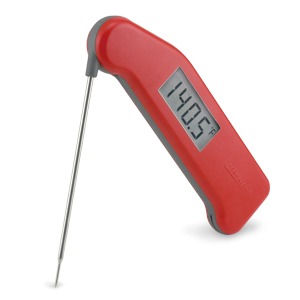
Classic Super-Fast® Thermapen


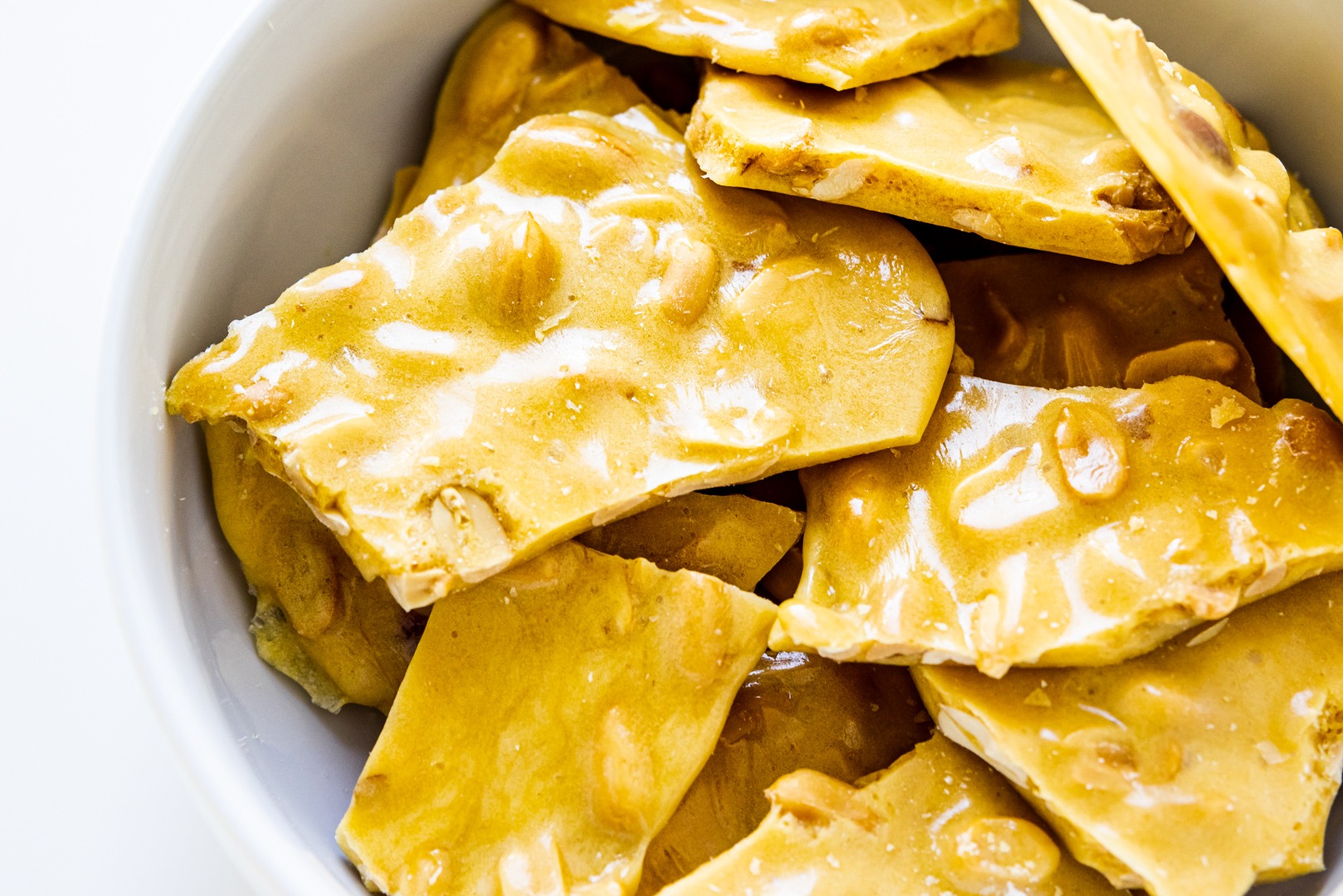
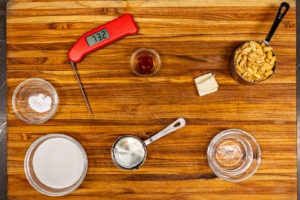
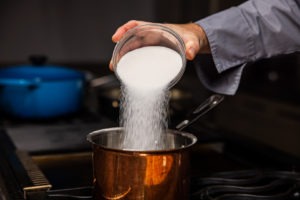
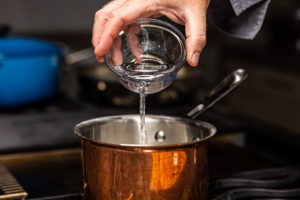
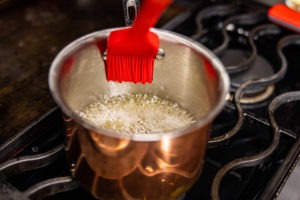
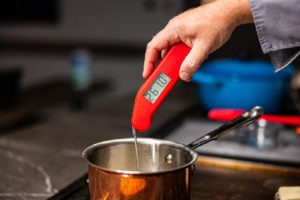
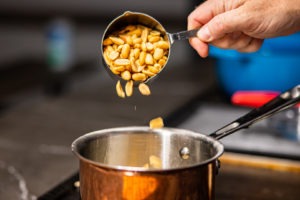
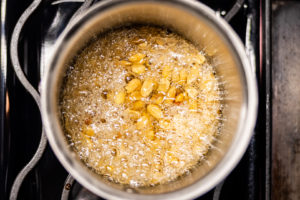
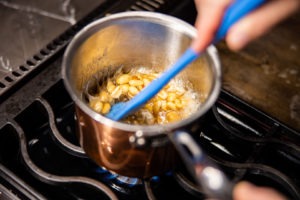
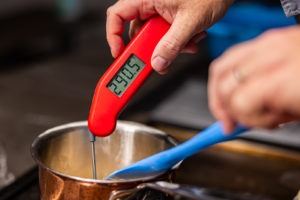
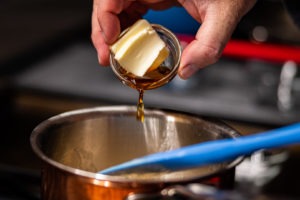
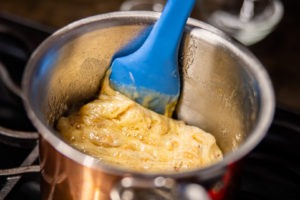
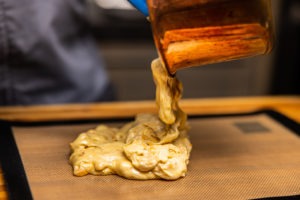
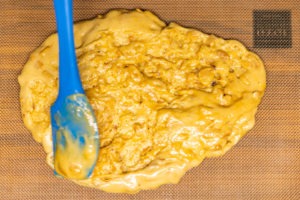
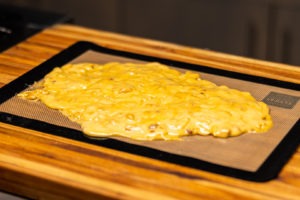
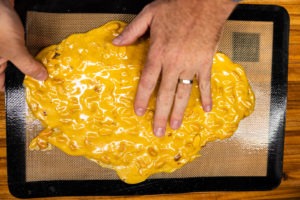
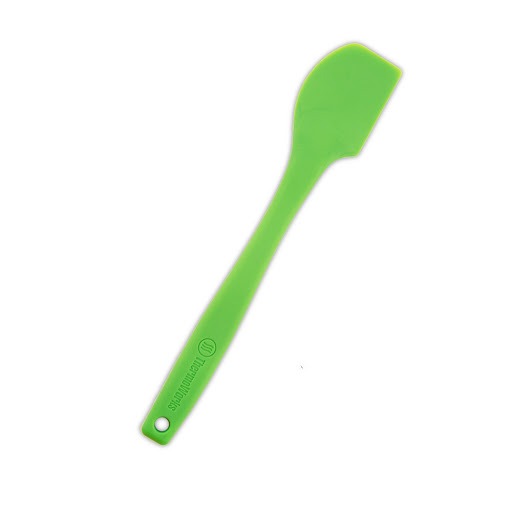
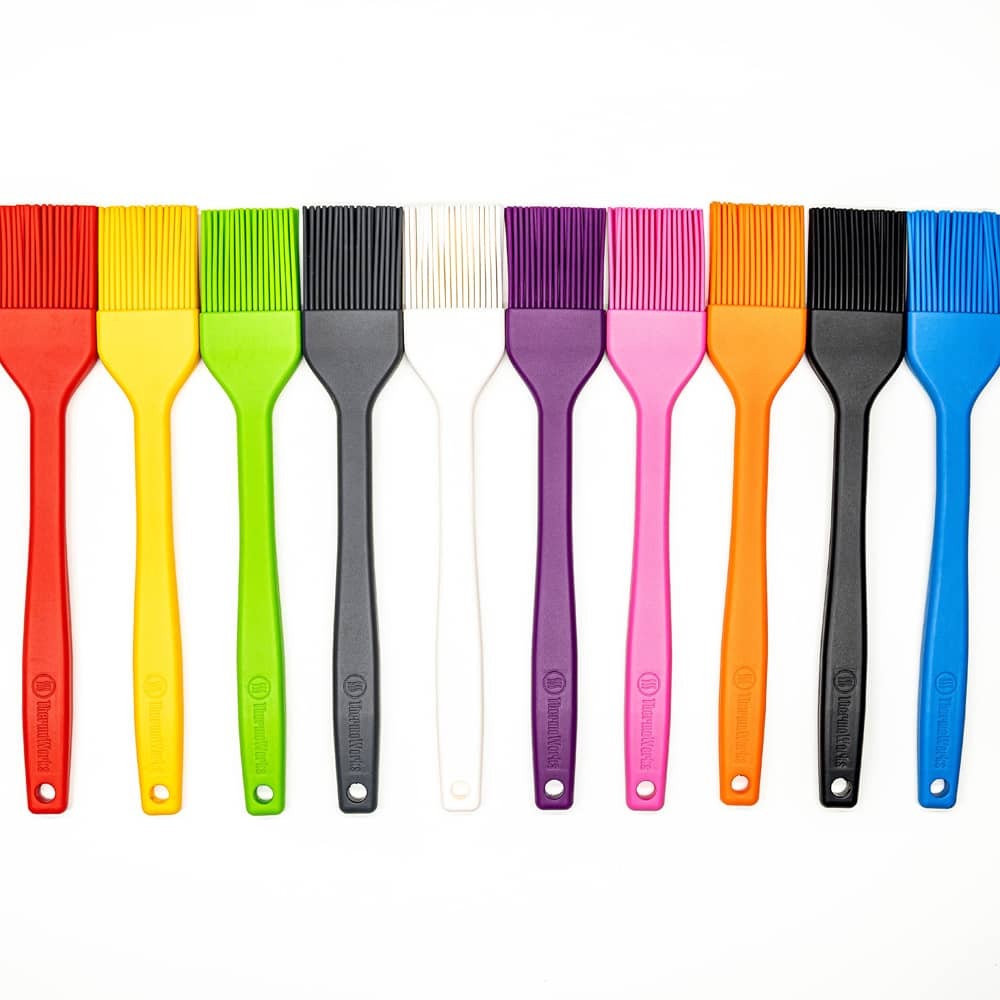
Your recipe on peanut brittle neglects to mention the effects of altitude on the required temperatures. I’m at 5500 feet above sea-level in the Denver area, and many nearby are higher than 8000 feet above sea level which causes a sharp drop in boiling temperatures. What do you recommend for temperature/altitude compensation?
Ed,
You are absolutely right! Altitude does have a considerable affect with sugar cooking temperatures, and we’re working on an upcoming post that addresses altitude’s affect on cooking. The best resource I’ve found on high altitude cooking is from the Colorado State University Extension http://extension.colostate.edu/topic-areas/nutrition-food-safety-health/high-altitude-food-preparation-p41/. It’s suggested to decrease the final cooking temperature by 2ºF for every 1,000 ft you are above sea level.
Thank you for your question!
-Kim
Waiting to try your peanut brittle recipe and appreciated the info on high-altitude adjustments. My question – can I use salted peanuts?
Lavonne,
Absolutely! Salted or unsalted is a matter of personal preference. We used roasted salted peanuts.
-Kim
Is there any details regarding to this subject in other languages?
Klimaya,
Unfortunately, at this time we do not have content available in different languages.
-Kim
Klimaya,
Unfortunately, at this time we do not have content available in different languages.
-Kim
Your said you use roasted peanuts. My Mother-in-law always used raw peanuts. Does it make a difference?
Debbie,
It will affect the final flavor of the brittle. Ours were actually roasted and salted–I like the roasted/salted flavor in the candy. Try making some with roasted and another batch with the raw. It’s really just a matter of personal preference. Thanks for the question, and Merry Christmas!
-Kim
Wanted to let you know that I had never attempted peanut brittle before, but your article inspired to to give it a try. My wife thought I was crazy for trying, but her and my friends now claim it’s the best they’ve ever had. I think we have now made 4 batches in the last 4 days and don’t think we’re done yet for the season. Thank you for your great recipes, suggestions, and products.
Wanted to let you know that I had never attempted peanut brittle before, but your article inspired to to give it a try. My wife thought I was crazy for trying, but her and my friends now claim it’s the best they’ve ever had. I think we have now made 4 batches in the last 4 days and don’t think we’re done yet for the season. Thank you for your great recipes, suggestions, and products.
Randy,
I’m so glad to hear the peanut brittle post helped you out! It’s a fun candy to put together. Merry Christmas!
-Kim
Please tell me what causes brittle to seize. I have made it for years. And last year we had 12 pots seize. I have never seen this.
Generally, it is an introduction of seed crystals. Dirty spoons, unwashed pan sides, sugar in the peanuts. Something like that will cause it to seize up. I can’t think of anything else…
I am in Colorado Springs at 6800 feet. I have made brittle for years and years. I use the same recipe all the time, but sometimes it does not keep the airy foamy texture. What am I doing wrong?? I Cook to 280 degrees for the altitude.
Good question! I don’t know exactly what might be wrong, but I have a couple of ideas. One is speed. Once the baking soda goes in, if it sits for too long, the air will leave and flatten the result. Get it mixed in and move to the end as fast as you can. It is possible, too, that there is some seed crystallization happening. If the candy forms up around a seed crystal quickly, it will hot be as airy. I’m sorry I don’t have an exact answer, but those two are my guesses.
I tried this recipe today after a different one did not turn out well. Followed the directions exactly and it is perfect! One problem is managing the stirring, the pan and the thermopen at the same time. A candy thermometer can just be clipped on to the pan.
It is a bit of a juggle, yes, but we have found the accuracy to be worth it! Glad it turned out so well!
Hello, Martin….
I can’t wait to try your recipe for the peanut.brittle. I have made a couple using my sisters recipe, and now want to experiment a little.
Your recipe does not say how much, poundage, it makes.
Can you tell me?
Thanks, and Happy Holidays!
Christie,
Whittier,
CA
It makes about 1 pound.
This is s wonderful post . Cooking is all about chemistry whether we know or appreciate it or not. I had a client, now deceased, that made the most wonderful peanut brittle every Christmas season and every year, he would bring a large box full of his delicacy to me and my office staff. It was the best I have ever had and I decided I would I would learn to make the same quality peanut brittle myself. I must have tried a couple of dozen different recipes, some by supposedly cooking gurus. None were nearly as good overall, as my client’s batches. I have thrown many of my batch efforts away as they missed the mark by a mile. The main difference was in the texture, or the softer bite that his finished product had. I like an “easy” to bite brittle that just wants to melt in your mouth. Most brittles have that hard crack characteristic. The taste may be fine but your teeth will not be pleased. Then I FINALLY discovered that the secret is NOT in the recipe, but rather in the sugar chemistry. When I made the switch in technique , I hit the jackpot!! The control of the sugar inversion and limited stirring made the difference, along with attention to detail in introducing sugar crystals into the mixture and also temperature control. Now I have brought the same quality of brittle back from the grave and I know well that my friend would be so proud. Thank you for such a great explanation. By the way, I hated chemistry in high school but absolutely loved it in college. It has followed me all my life.
Thank you for the info on the chemistry of baking soda! I have been making peanut brittle (raw Spanish) for many years since finding a microwave recipe! SOOOO easy! I am now venturing out into other nuts! It is trial and error right now until I get just the right about of cooking time because not all nut are created equal!! Especially almonds! But I will keep at it! So far the walnut and the pecan brittles are turning out great! Pistacio is next on the agenda! I have won Blue Ribbons 2 years in a row now with my peanut brittle at the Southern New Mexico State Fair.
Wonderful! We’re happy to help you in your quest for Fair domination!
I have always used the GE microwave recipe and get perfect melt in your mouth peanut brittle every time. My son has a peanut allergy and I’ve tried to make brittle with no nuts…which always turns out flat and extremely hard. Then I moved to making it on the stove and get the same results…very flat hard candy, even though I make it with the same baking soda. It’s like all the bubbles disappear or are extremely small. I tried making it with pretzels today which kinda worked, but once again the bubbles are non-existent compared to when I make it with peanuts and it’s hard on the teeth. Why are all my baking soda bubbles disappearing (really they’re just super small)? I don’t feel like I’m stirring it too much and it’s fluffy when I pour it on a cookie sheet to cool. Is it cooling too fast or too slow compared to the peanut brittle? Thanks!
I suspect that the temperature is getting too high because the peanuts aren’t there to act as a heat buffer. Maybe pull it form heat and add the butter, vanilla, and soda 3°F sooner.